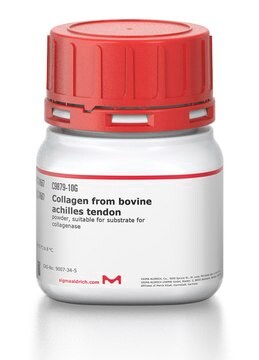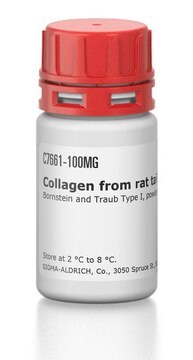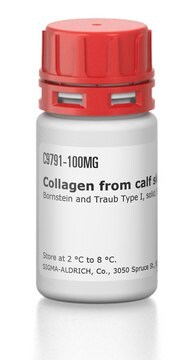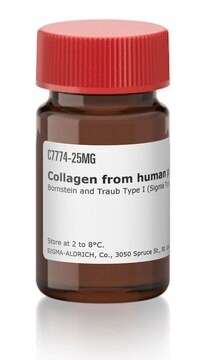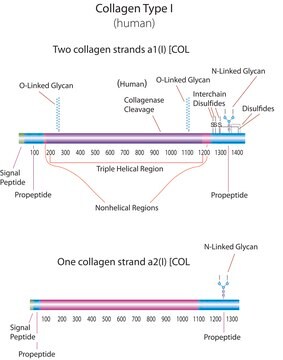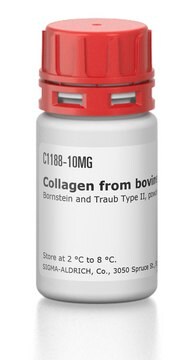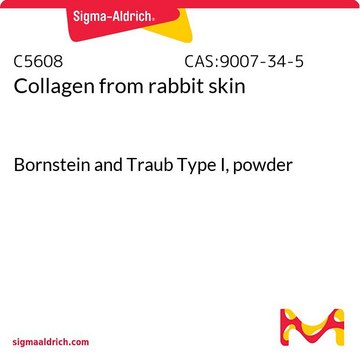5162
Bovine Collagen Type I
from bovine flexor tendon, powder, suitable for cell culture, used for 3D gel formation
Sinonimo/i:
Collagen Protein, Collagen Solution, Collagen Type I
About This Item
Prodotti consigliati
product name
Collagen, from bovine flexor tendon
Origine biologica
bovine flexor tendon
Sterilità
non-sterile
Saggio
>96%
Forma fisica
lyophilized powder (fibrous)
Confezionamento
pkg of 1 g
tecniche
cell culture | mammalian: suitable
N° accesso UniProt
Specificità del legame
Peptide Source: Elastin
Peptide Source: Fibronectin
Peptide Source: Laminin
Condizioni di spedizione
wet ice
Temperatura di conservazione
room temp
Informazioni sul gene
bovine ... COL2A1(407142)
Descrizione generale
This collagen product is naturally cross-linked yielding a robust material for applications which require structure and strength. This product can be readily prepared into such forms as tissue scaffolds, foams, sponges, suspensions, coatings, putties, films and sheets but does not form hydrogels. Using typical cross-linking methods, this material can be tuned for optimal in vivo resorption. This collagen product is ideal for tissue engineering applications and uses with inorganic and biomaterials.
The product is provided in user-friendly packaging for use and storage. Avoid extended exposure to ambient environment since this material is hygroscopic.
Nota sulla preparazione
Note: The following procedure is based on solubilization of 1 gram of collagen in 100 ml to initially prepare a 10 mg/ml collagen suspension. Smaller quantities and volumes may be used but the same ratios of collagen and solutions should be used.
1. Weigh out 1 gram of collagen fibrous powder.
2. Reconstitute 1 gram of collagen with 50 ml of cold purified water (50% of the final volume).
3. Stir the collagen with the water continuously mixing for a minimum of 15 minutes until the collagen is fully wetted and the suspension appears to be a semi-solution.
4. Add 50 ml of cold 0.02 M HCl to the collagen mixture and stir for a minimum of 10 minutes. This will yield a collagen concentration of 10 mg/ml with the suspension continuing to appear as a semi-solution.
5. Measure the pH - the mixture should have a pH of 2 to 3.
6. Using Waring stick blender or equivalent, homogenize the collagen mixture for a minimum of 15 minute at a high speed ensuring that the collagen is fully homogenized. Ensure that the temperature of mixture does exceed 24°C. Upon completion, there should be no visual solids in the viscous suspension. Air bubbles with be prevalent.
7. To remove air bubbles, stir the solution on a stir plate and pull a vacuum on the suspension. This will remove the air bubbles.
8. At this point if a collagen concentration of less than 10 mg/ml is desired, the collagen can be diluted with 0.01 M HCl.
Altre note
Applications
General Filtration of 15 to 50 mL Samples, Preparation for Scintillation Counting
XX2702550 1225 Sampling Manifold
Replacement Parts
YY2214257 Hand Knob
5162 Top Plate
XX2702509 Filter O-ring, silicone
5163 Support Plate
XX2702510 Support Screen, 25 mm, polypropylene
XX11000PP Ball Valve, glass-filled polypropylene
XX2504755 Tubing, 1/4 in. x 23 in., latex
Accessories
XX2702552 Chamber O-rings and Plug Set
XX2702555 Sample Cup Extension Barrel
XX6200006P Filter Forceps, blunt end, stainless steel
XX7100004 Tubing 3/16 in. I.D. x 140 cm, silicone
Codice della classe di stoccaggio
11 - Combustible Solids
Classe di pericolosità dell'acqua (WGK)
WGK 1
Punto d’infiammabilità (°F)
Not applicable
Punto d’infiammabilità (°C)
Not applicable
Certificati d'analisi (COA)
Cerca il Certificati d'analisi (COA) digitando il numero di lotto/batch corrispondente. I numeri di lotto o di batch sono stampati sull'etichetta dei prodotti dopo la parola ‘Lotto’ o ‘Batch’.
Possiedi già questo prodotto?
I documenti relativi ai prodotti acquistati recentemente sono disponibili nell’Archivio dei documenti.
I clienti hanno visto anche
Il team dei nostri ricercatori vanta grande esperienza in tutte le aree della ricerca quali Life Science, scienza dei materiali, sintesi chimica, cromatografia, discipline analitiche, ecc..
Contatta l'Assistenza Tecnica.